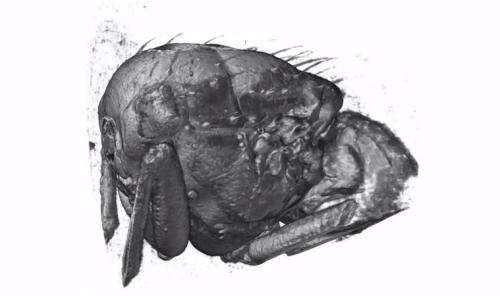3-D video from inside flying insects

The flight muscles moving inside flies have been filmed for the first time using a new 3D X-ray scanning technique.
3D movies of the muscles were created by a team from Oxford University, Imperial College London, and the Paul Scherrer Institute (PSI), using the PSI's Swiss Light Source, a powerful X-ray source. The movies offer a glimpse into the inner workings of one of nature's most complex mechanisms, the blowfly's flight motor, and could inspire new designs of micro air vehicle and other micromechanisms.
A report of this research, including the 3D movies, is published in this week's PLOS Biology.
In the time that it takes a human to blink, a blowfly [Calliphora vicina] can beat its wings 50 times, controlling each wingbeat using numerous tiny steering muscles – some as thin as a human hair. The membranous wings contain no muscles, so all of the flight muscles are hidden out of sight within the thorax.
'The thoracic tissues block visible light, but can be penetrated by X-rays,' said Dr Rajmund Mokso from the PSI. 'By spinning the flies around in the dedicated fast-imaging experimental setup at the Swiss Light Source, we recorded radiographs at such a high speed that the flight muscles could be viewed from multiple angles at all phases of the wingbeat. We combined these images into 3D visualizations of the flight muscles as they oscillated back and forth 150 times per second.'
The flies responded to being spun around by trying to turn in the opposite direction, allowing the scientists to record the asymmetric muscle movements associated with turning flight.
'The key question is how the fly's tiny steering muscles, which make up less than 3% of its total flight muscle mass, influence the output of the much larger muscles that power its flight,' said Professor Graham Taylor of Oxford University's Department of Zoology who led the research in Oxford. 'We found that blowflies have evolved a mechanism rather like the differential in a car; whilst the power delivered to the fly's wings on each side remains the same, the fly effectively 'brakes' on one side by diverting excess power into a steering muscle specialized to absorb mechanical energy.'
Professor Taylor said: 'We hope that our new understanding of this clever design, which produces large, complex 3D movements using actuators that only generate small, simple one-dimensional motions, will inspire the development of new micro air vehicles and other micromechanical devices.'
Dr Simon Walker from Oxford University, joint first author of the study with Daniel Schwyn, said: 'The fly's wing hinge is probably the most complex joint in nature, and is the product of more than 300 million years of evolutionary refinement. The result is a mechanism that differs dramatically from conventional manmade designs; built to bend and flex rather than to run like clockwork.'
More information: Walker SM, Schwyn DA, Mokso R, Wicklein M, Müller T. et al. (2014) In Vivo Time-Resolved Microtomography Reveals the Mechanics of the Blowfly Flight Motor. PLoS Biol 12(3): e1001823. DOI: 10.1371/journal.pbio.1001823
Journal information: PLoS Biology
Provided by Oxford University
















